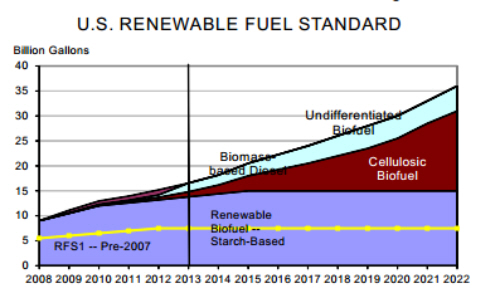



CME: Would RFS Waiver Affect Corn Prices?
US - This week’s hot topic is whether a partial or complete waiver of the renewable fuel standard (RFS) would have any material impact on corn prices, write Steve Meyer and Len Steiner.Several livestock groups have petitioned the EPA administrator to enact such a waiver. Those requests
may or may not be answered but similar requests from at least four
governors must be addressed by EPA. At least three groups of economists have weighed in on the debate and the general conclusion at this time is that a waiver may not do much to reduce the amount of
corn used by ethanol manufacturers and would thus driven a relatively
small reduction in prices. Let’s review the issues at hand and how they
may come to bear on the market situation.
The Renewable Fuel Standard is a series of requirements in
the 2007 Energy Act that mandates amounts of various biofuels that
must be used each year. The standard applies to biodiesel and cellulosic biofuels but the one of interest in this debate is the category of
renewable biofuels which basically includes only corn-based ethanol.
The requirements are for a calendar years’ usage — a fact that confounds usage numbers a bit already since the calendar year does no
match the September-August crop year we use in the corn balance
sheet. The corn ethanol mandates for 2012 and 2103 are 13.2 and
13.8 billion gallons, respectively. Weighting those proportionately
gives a mandate level of 13.6 billion gallons for the ‘12-’13 crop year.
At an ethanol yield of 2.8 gallons/bu., that would require 4.857 billion
bushels of corn. USDA’s current estimate is 4.500 billion bushels.
But there is some flexibility built into the law. Blenders have
used more ethanol than was required in past years, thus generating
credits called RINs that can be used to satisfy part of this year’s mandate. No one knows just how many RINs are out there but the consensus is that there are 2 to 2.5 billion gallons (715 to 900 million
bushels) worth available. In addition, ethanol stocks are still larger
than normal and these stocks can be used to meet some of the RFS
requirements for the rest of 2012 and 2013.
A major issue in the debate at present is just how much operational flexibility exists at the blender level. The question is whether
the current use of ethanol as an octane enhancement for motor fuels
will allow a reduction in its usage in the short run. Note that this is
octane enhancement, not oxygenate — the use that drove ethanol
prices through the roof back in 2006 when MTBE was withdrawn from
the market over environmental concerns. The argument is that refineries are making gas with roughly 84 octane and changing that practice
will be difficult and costly so refineries may not do it — especially if the
waiver is perceived to be for only one year. If blenders either cannot
or will not change this practice, then any waiver to the RFS will have
little impact. This was a primary part of the discussion by Purdue researchers on the Farm Foundation’s webinar yesterday morning.
We have heard from other sources, though, that octane usage and inflexibility are not as large as has been touted and that refiners would change quickly if allowed to do so. Someone needs to determine the truth on this one because it is quite critical to the outcome.
Another major driver of ethanol usage is, of course, the price
of gasoline. Higher gasoline prices were a major factor that drove
researchers at Iowa State’s Center for Agricultural and Rural Development (CARD) to revise a paper they published in July. Higher gas
prices drive greater market demand for ethanol which, in turn, reduces
the importance of the mandate and would reduce the impact of waiving all or part of the mandate. While not a month-to-month comparison like that of the CARD paper, the Purdue research implicitly recognizes this fact by identifying crude oil prices as a key variable.
They
postulate that a waiver will have little or not impact if the oil price is
above $120. They allow that it would have some impact if prices are
below $100 and there is sufficient flexibility at the blender level.
So what does this mean in dollars? The tables below show
the key results of the CARD and Purdue papers. The CARD model
used 500 draws from the distributions of each stochastic variable and
presented the average outcome. The Purdue paper looked at various
scenarios regarding ethanol usage flexibility and drought severity. We
show the results for their “strong drought” and the flexibility cases that
include the use of RINs.
Are these right? No one knows right now and the issue of
blending flexibility is critical. Stay tuned for more!









